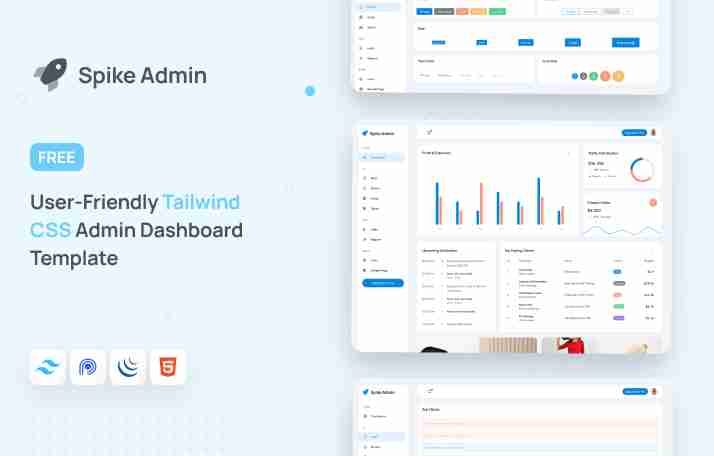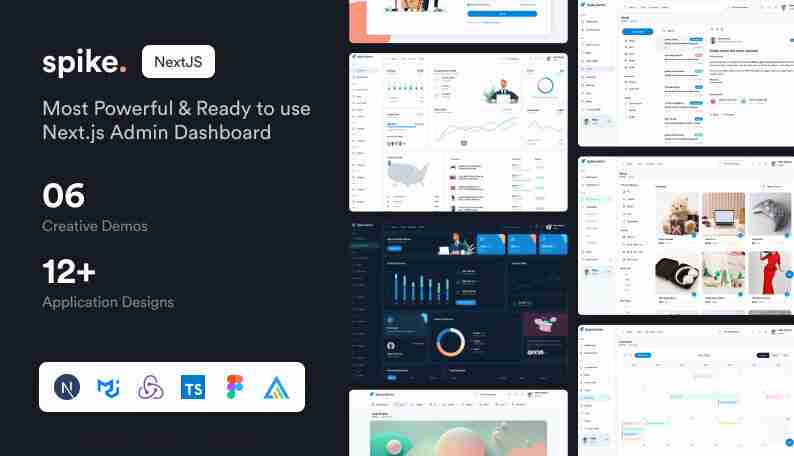 Web Front-end
Web Front-end
 JS Tutorial
JS Tutorial
 Integrating Tailwind CSS with Other Frontend Frameworks for Admin Panels
Integrating Tailwind CSS with Other Frontend Frameworks for Admin Panels
Integrating Tailwind CSS with Other Frontend Frameworks for Admin Panels
Admin panels are essential tools for managing and analyzing data efficiently in modern web applications. Tailwind CSS, a highly customizable utility-first CSS framework, is rapidly becoming the go-to choice for creating clean and responsive interfaces. By combining Tailwind CSS with frameworks like React, Angular, Vue.js, and Next.js, developers can build powerful and visually stunning admin panels. In this blog, we’ll explore the benefits of integrating Tailwind CSS admin templates with other frontend frameworks, along with a showcase of some popular templates.
Why Use Tailwind CSS for Admin Panels?
1. Customization Flexibility
Tailwind CSS allows developers to define custom themes and styles directly in their projects. This flexibility makes it easy to match the branding and design requirements of an admin panel.
2. Predefined Utility Classes
With a rich library of utility classes, Tailwind CSS eliminates the need to write repetitive CSS, enabling faster development.
3. Responsive Design
Tailwind CSS simplifies responsive design with built-in classes for different screen sizes, ensuring admin panels look great on any device.
4. Integration Compatibility
Tailwind CSS can be integrated seamlessly with modern frontend frameworks, making it a versatile choice for building dynamic and interactive admin panels.
Integrating Tailwind CSS with Frontend Frameworks
1. React and Tailwind CSS
React’s component-based architecture pairs well with Tailwind CSS. Using libraries like Create React App or Next.js, developers can quickly set up projects with Tailwind’s utility-first styling.
-
Recommended Template:
Flexy React Material Dashboard
 Demo Link
Demo Link
2. Angular and Tailwind CSS
Angular’s robust framework combined with Tailwind CSS can produce highly interactive admin panels. Tailwind can be integrated into Angular CLI projects for seamless styling.
-
Recommended Template:
MaterialPro Angular Dashboard
 Demo Link
Demo Link
3. Vue.js and Tailwind CSS
Vue.js provides simplicity and flexibility, making it ideal for projects using Tailwind CSS. Developers can quickly create scalable admin panels with minimal boilerplate code.
-
Recommended Template:
Spike Vue.js Admin Template
 Demo Link
Demo Link
4. Next.js and Tailwind CSS
Next.js offers server-side rendering and static site generation capabilities, making it an excellent choice for Tailwind CSS admin panels that prioritize performance.
-
Recommended Template:
MaterialPro Next.js Admin Dashboard
 Demo Link
Demo Link
5. Nuxt.js and Tailwind CSS
For Vue-based SSR projects, Nuxt.js works seamlessly with Tailwind CSS to deliver feature-rich admin panels.
-
Recommended Template:
Spike Nuxt.js Admin Template
 Demo Link
Demo Link
Free and Premium Tailwind CSS Admin Templates
Free Options
- Spike Free Tailwind Admin Template

Demo Link
-
Flexy Free Next.js Admin Template
 Demo Link
Demo Link
Premium Options
Spike Next.js Admin Template

Demo LinkFlexy Bootstrap Admin Template

Demo Link
Conclusion
Integrating Tailwind CSS admin templates with popular frameworks like React, Angular, Vue.js, Next.js, and Nuxt.js can significantly enhance the development process. Whether you’re creating a dynamic dashboard for data analysis or a sleek admin panel for backend management, Tailwind CSS provides the tools and flexibility to build a feature-rich interface.
Looking for ready-to-use templates? Check out platforms like WrapPixel for an extensive collection of free and premium Tailwind CSS admin templates tailored to your needs.
Explore More Templates:
For a broader selection of templates, visit WrapPixel or AdminMart.
The above is the detailed content of Integrating Tailwind CSS with Other Frontend Frameworks for Admin Panels. For more information, please follow other related articles on the PHP Chinese website!

Hot AI Tools

Undresser.AI Undress
AI-powered app for creating realistic nude photos

AI Clothes Remover
Online AI tool for removing clothes from photos.

Undress AI Tool
Undress images for free

Clothoff.io
AI clothes remover

Video Face Swap
Swap faces in any video effortlessly with our completely free AI face swap tool!

Hot Article

Hot Tools

Notepad++7.3.1
Easy-to-use and free code editor

SublimeText3 Chinese version
Chinese version, very easy to use

Zend Studio 13.0.1
Powerful PHP integrated development environment

Dreamweaver CS6
Visual web development tools

SublimeText3 Mac version
God-level code editing software (SublimeText3)

Hot Topics
 1662
1662
 14
14
 1418
1418
 52
52
 1311
1311
 25
25
 1261
1261
 29
29
 1234
1234
 24
24
 Demystifying JavaScript: What It Does and Why It Matters
Apr 09, 2025 am 12:07 AM
Demystifying JavaScript: What It Does and Why It Matters
Apr 09, 2025 am 12:07 AM
JavaScript is the cornerstone of modern web development, and its main functions include event-driven programming, dynamic content generation and asynchronous programming. 1) Event-driven programming allows web pages to change dynamically according to user operations. 2) Dynamic content generation allows page content to be adjusted according to conditions. 3) Asynchronous programming ensures that the user interface is not blocked. JavaScript is widely used in web interaction, single-page application and server-side development, greatly improving the flexibility of user experience and cross-platform development.
 The Evolution of JavaScript: Current Trends and Future Prospects
Apr 10, 2025 am 09:33 AM
The Evolution of JavaScript: Current Trends and Future Prospects
Apr 10, 2025 am 09:33 AM
The latest trends in JavaScript include the rise of TypeScript, the popularity of modern frameworks and libraries, and the application of WebAssembly. Future prospects cover more powerful type systems, the development of server-side JavaScript, the expansion of artificial intelligence and machine learning, and the potential of IoT and edge computing.
 JavaScript Engines: Comparing Implementations
Apr 13, 2025 am 12:05 AM
JavaScript Engines: Comparing Implementations
Apr 13, 2025 am 12:05 AM
Different JavaScript engines have different effects when parsing and executing JavaScript code, because the implementation principles and optimization strategies of each engine differ. 1. Lexical analysis: convert source code into lexical unit. 2. Grammar analysis: Generate an abstract syntax tree. 3. Optimization and compilation: Generate machine code through the JIT compiler. 4. Execute: Run the machine code. V8 engine optimizes through instant compilation and hidden class, SpiderMonkey uses a type inference system, resulting in different performance performance on the same code.
 JavaScript: Exploring the Versatility of a Web Language
Apr 11, 2025 am 12:01 AM
JavaScript: Exploring the Versatility of a Web Language
Apr 11, 2025 am 12:01 AM
JavaScript is the core language of modern web development and is widely used for its diversity and flexibility. 1) Front-end development: build dynamic web pages and single-page applications through DOM operations and modern frameworks (such as React, Vue.js, Angular). 2) Server-side development: Node.js uses a non-blocking I/O model to handle high concurrency and real-time applications. 3) Mobile and desktop application development: cross-platform development is realized through ReactNative and Electron to improve development efficiency.
 How to Build a Multi-Tenant SaaS Application with Next.js (Frontend Integration)
Apr 11, 2025 am 08:22 AM
How to Build a Multi-Tenant SaaS Application with Next.js (Frontend Integration)
Apr 11, 2025 am 08:22 AM
This article demonstrates frontend integration with a backend secured by Permit, building a functional EdTech SaaS application using Next.js. The frontend fetches user permissions to control UI visibility and ensures API requests adhere to role-base
 Python vs. JavaScript: The Learning Curve and Ease of Use
Apr 16, 2025 am 12:12 AM
Python vs. JavaScript: The Learning Curve and Ease of Use
Apr 16, 2025 am 12:12 AM
Python is more suitable for beginners, with a smooth learning curve and concise syntax; JavaScript is suitable for front-end development, with a steep learning curve and flexible syntax. 1. Python syntax is intuitive and suitable for data science and back-end development. 2. JavaScript is flexible and widely used in front-end and server-side programming.
 From C/C to JavaScript: How It All Works
Apr 14, 2025 am 12:05 AM
From C/C to JavaScript: How It All Works
Apr 14, 2025 am 12:05 AM
The shift from C/C to JavaScript requires adapting to dynamic typing, garbage collection and asynchronous programming. 1) C/C is a statically typed language that requires manual memory management, while JavaScript is dynamically typed and garbage collection is automatically processed. 2) C/C needs to be compiled into machine code, while JavaScript is an interpreted language. 3) JavaScript introduces concepts such as closures, prototype chains and Promise, which enhances flexibility and asynchronous programming capabilities.
 Building a Multi-Tenant SaaS Application with Next.js (Backend Integration)
Apr 11, 2025 am 08:23 AM
Building a Multi-Tenant SaaS Application with Next.js (Backend Integration)
Apr 11, 2025 am 08:23 AM
I built a functional multi-tenant SaaS application (an EdTech app) with your everyday tech tool and you can do the same. First, what’s a multi-tenant SaaS application? Multi-tenant SaaS applications let you serve multiple customers from a sing



 Demo Link
Demo Link
 Demo Link
Demo Link
 Demo Link
Demo Link
 Demo Link
Demo Link
 Demo Link
Demo Link
 Demo Link
Demo Link


